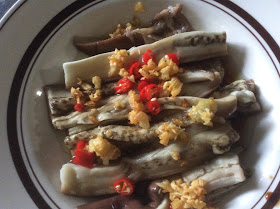Remember Popeye, the sailor man? Spinach was the super food that gave him his strength. Whenever he wants to defeat his enemies, he will open a can and eat his spinach out of the can.
Unlike Popeye, most of the time we stir-fry our spinach with anchovies or just with lots of garlic and season with light soy sauce and salt. Sometimes we cook soup with it. Or, we can add spinach to our pizza or spaghetti. How many of us think about making omelette with it?
Well, I make spinach omelette quite often; it is easy to make and is delicious to our taste buds.
- Firstly, remove the roots of the spinach.
- Wash and soak the spinach at least 3 times to ensure all the soil is removed.
- Squeeze the spinach to remove water from it.
- Cut the spinach finely and set aside.
- Beat a few eggs (enough to cover the cut spinach) into a bowl. Season the eggs with salt, light soy sauce and pepper.
- Add the spinach to the eggs and stir well to mix completely.
- Heat the wok with 2-3 tablespoons of oil.
- When the oil is heated up, pour the egg batter into the wok and spread it out thinly. Turn the heat to medium.
- When the bottom is browned, flip the omelette over to cook the other side.
- When the other side is cooked, dish the omelette out onto a serving dish.























